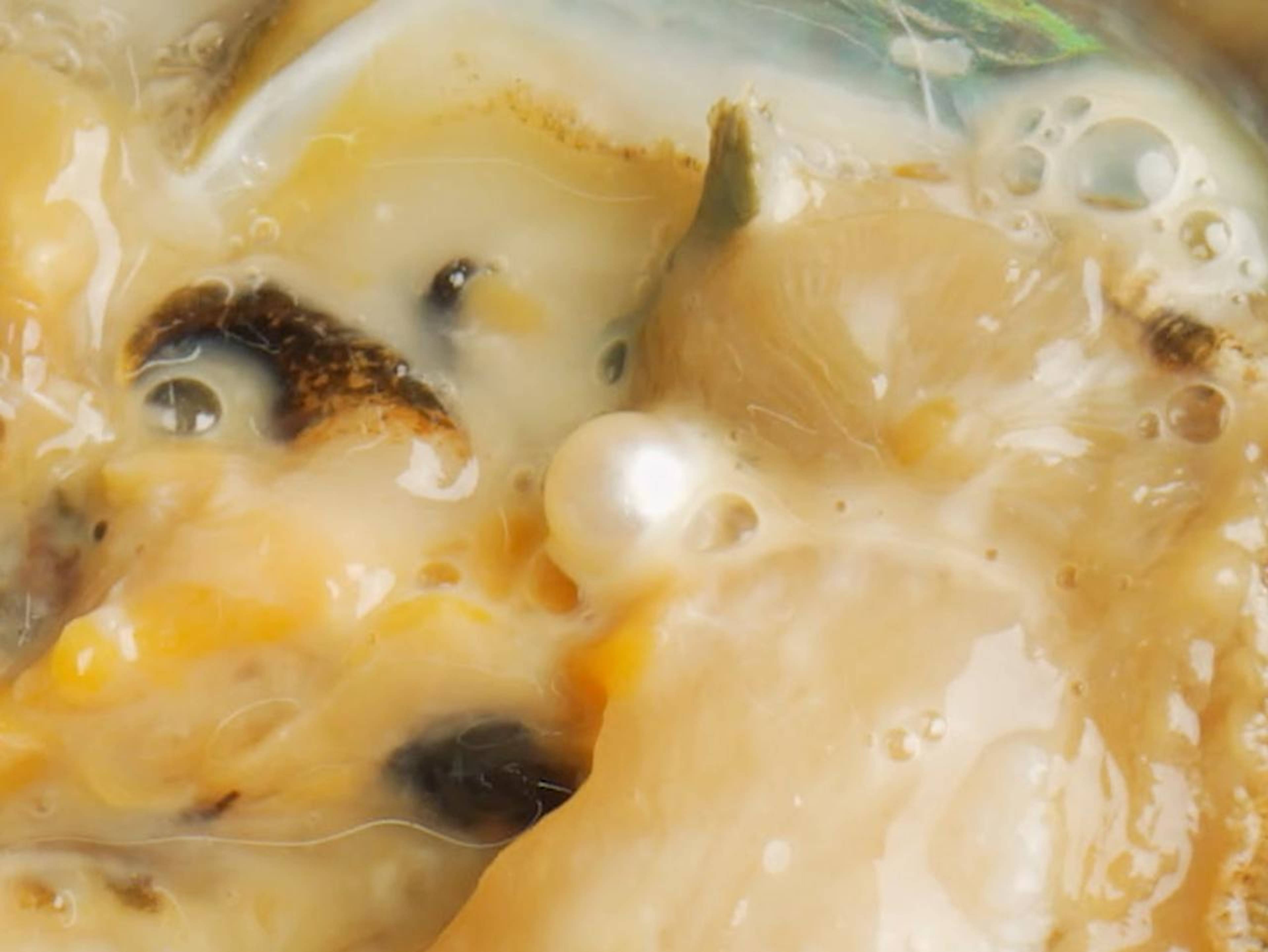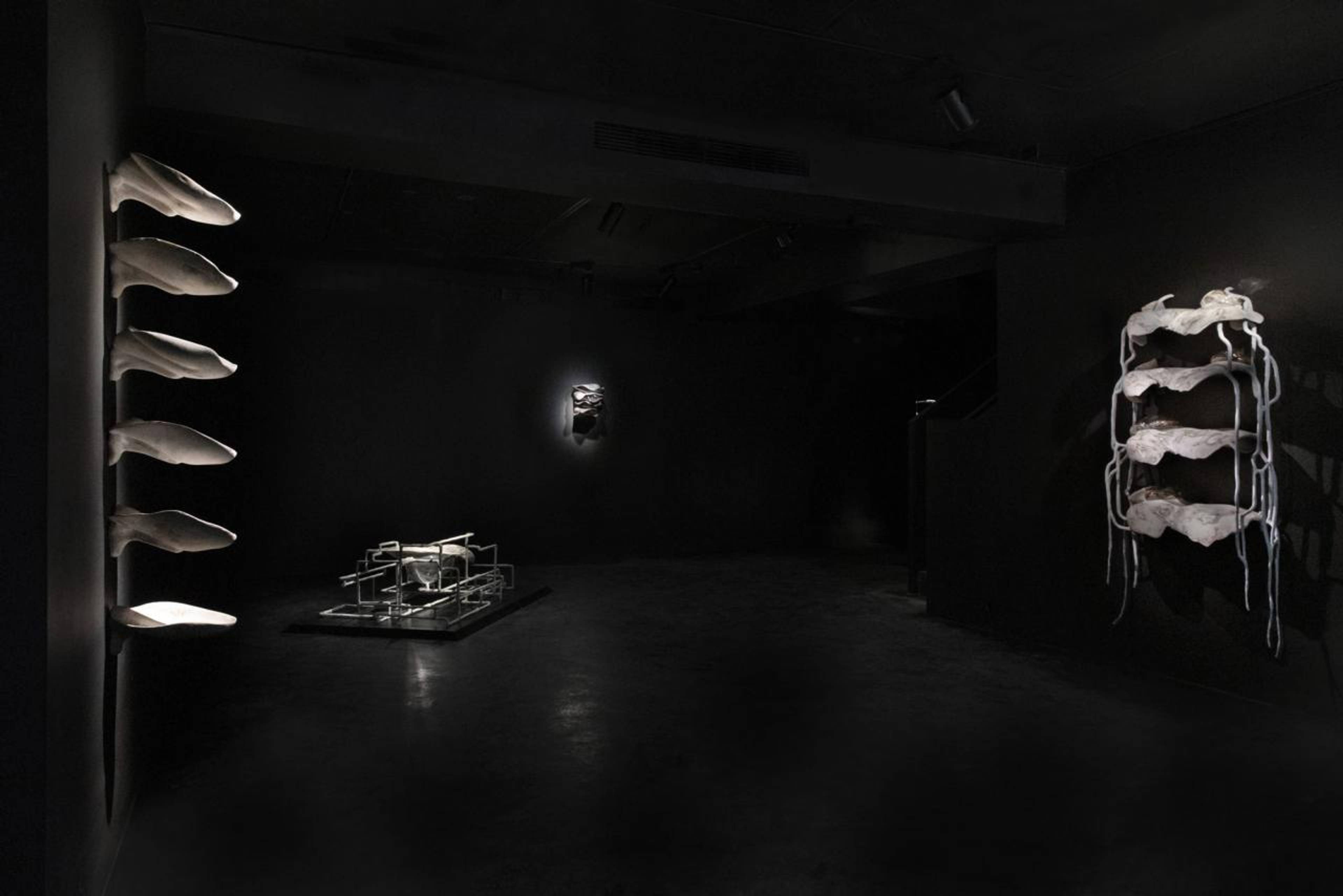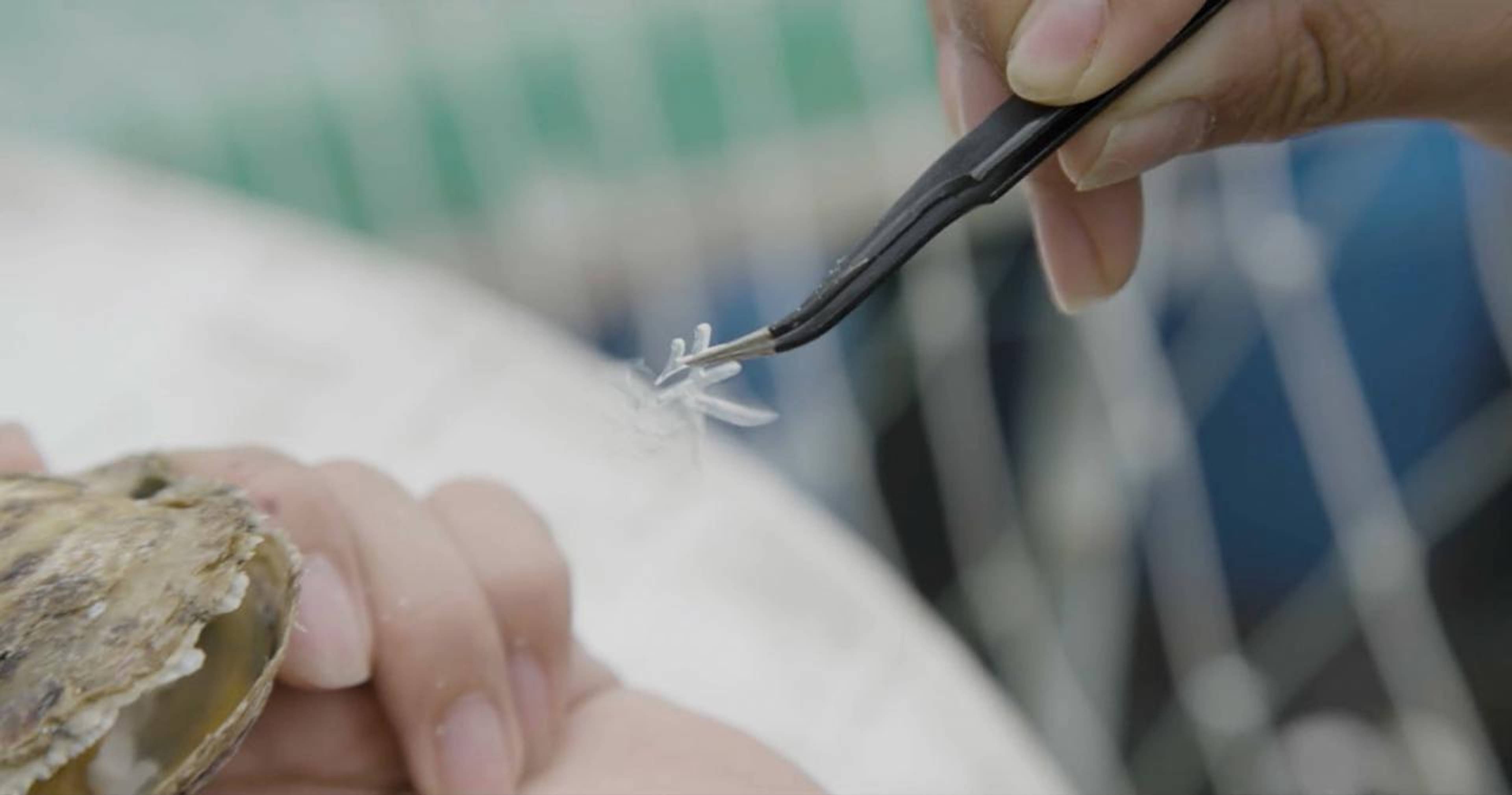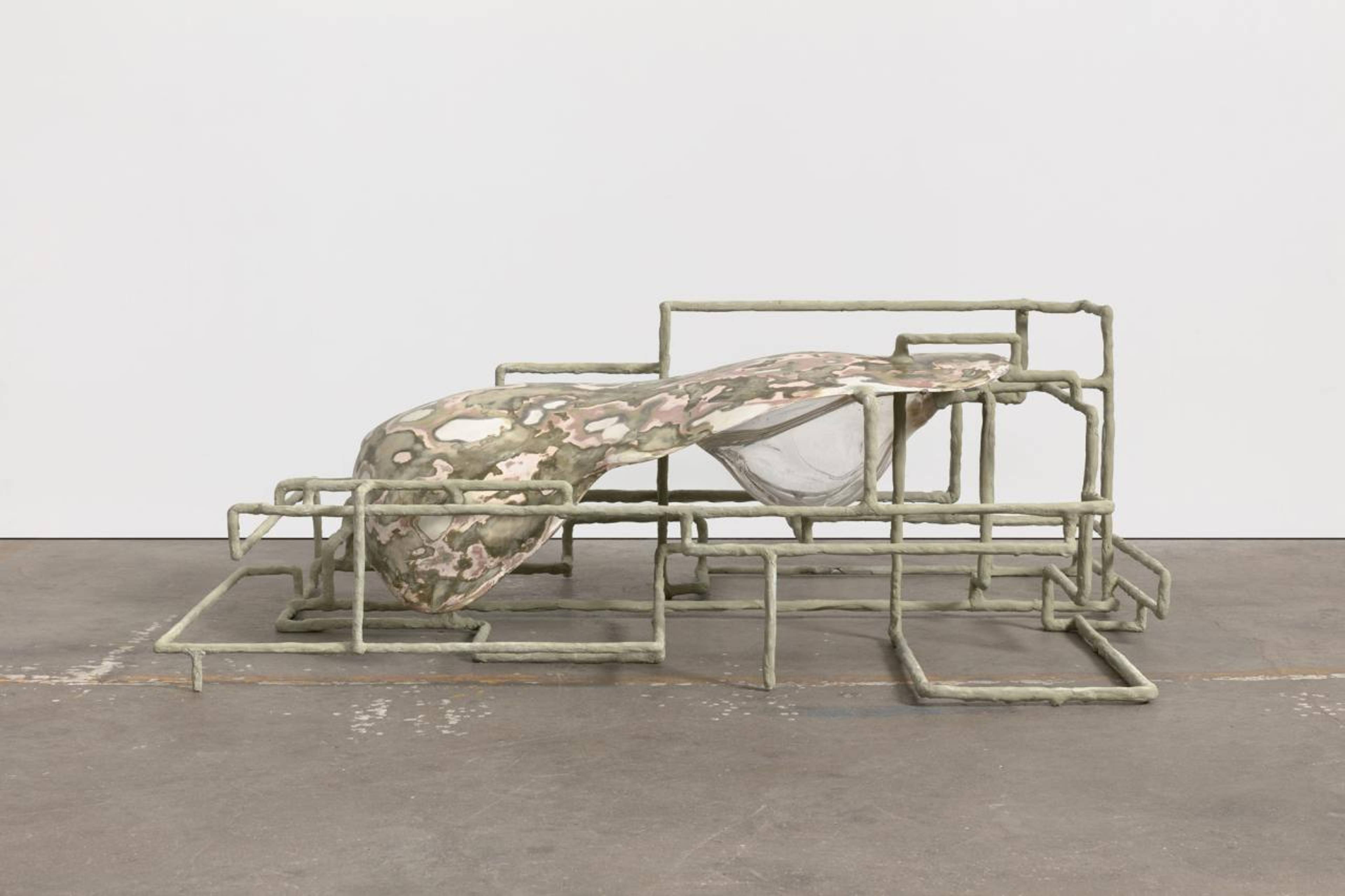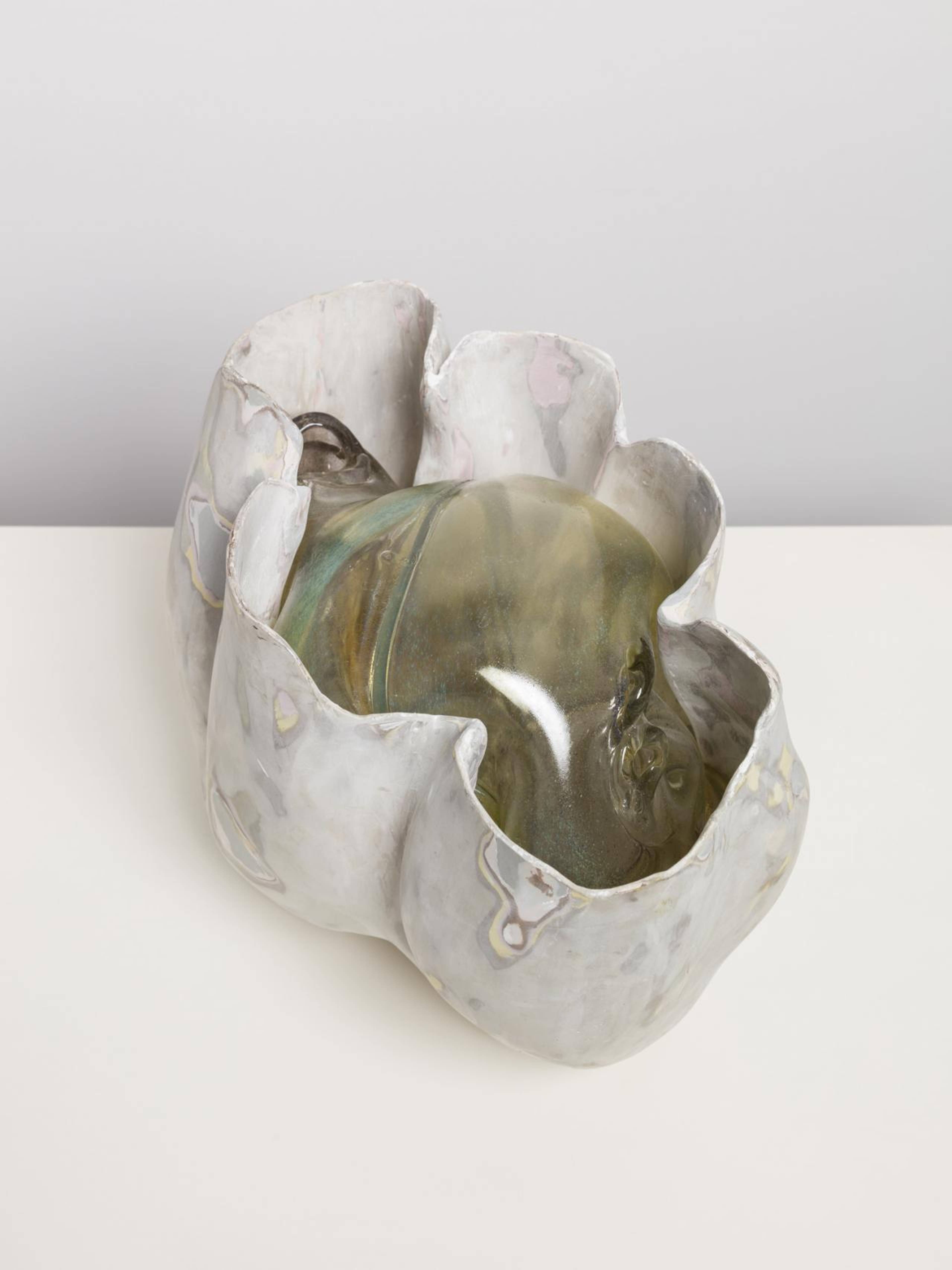Across the road from Empty Gallery, at the Aberdeen waterfront, fishing boats unload their catches every morning at a local seafood market. This briny atmosphere is vividly conjured within the gallery at Jes Fan’s (*1990) latest solo exhibition, “Sites of Wounding: Chapter 1,” which takes pearl farming as a starting point for the artist’s expanding inquiry into extractive industries.
For the past three years, Fan has worked with Pinctada fucata, a pearl-oyster species native to the waters around Hong Kong. These mollusks are prized for their strong nacre (the iridescent inner lining of their shells), which makes them commercially viable for industrial pearl cultivation. Fan’s wall-mounted sculpture Diagram XIX (2023) renders a stack of four oyster-shaped forms in smooth aqua-resin, with dapples of pink, slate, and sage that simultaneously evoke the polychromatic patterns of seashells and military camouflage. A glass bubble expands from the mouth of one mollusk as if blown by the sculpture in situ.
View of “Sites of Wounding: Chapter 1,” Empty Gallery, Hong Kong, 2023. All images courtesy: the artist and Empty Gallery, Hong Kong. Photo: Michael Yu
Its delicate appearance belies the actual force involved in pearl cultivation, as depicted in the video Palimpsest (2023). Glorious scenes of glittering waves and spiral shoals of fish are juxtaposed with footage of hands gouging open live oysters and using tweezers to insert pearl nuclei into their gonads. Over time, the onscreen captions explain, the organisms secrete nacre to cover these foreign objects – a defensive mechanism that yields the coveted gems. Close-ups of glistening oyster flesh are accompanied by sounds of sucking, squelching, and clicking – a visceral reminder of violence that resonates throughout the exhibition space.
Fan connects this process of injury and assimilation to negotiations of foreign power in Hong Kong, which is still fetishistically referred to as the “Pearl of the Orient.” In the video, the oysters are implanted with nuclei shaped like the Chinese characters for the former British colony’s sobriquet; “I want it to swallow its own name/And turn its name into itself,” the captions state. There are glimpses of the cityscape reflected in a bus stop’s plexiglass advertising panel and the mirrored ceiling above the escalators of a shopping mall. Hong Kong is portrayed as a mirage invoked by the imperatives of politics and global capital.
Jes Fan, Diagram XIX, 2023, aqua resin, glass, and pigments. Photo: Pierre Le Hors
Yet there is power in mutability (and mutation). In the floor-based sculptures Bivalve I and Bivalve II (both 2023), aqua-resin shells that span nearly a meter wide are fused to pipe-like armatures. Despite their rigid material, the oval plates exude the semblance of flexibility, curving and draping over the angular metal frames as large blown-glass blobs drip from their undersides. The works are reminiscent of two of Fan’s earlier series: “Systems” (2018), in which glass sacs incorporating melanin and human sex hormones slouch on wooden lattices; and “Networks” (2021), comprising sets of interconnected glass vessels designed to incubate black mold. This context heightens the ambiguity of the new pieces: Are the tubular constructions of “Bivalves” a cage, or a kind of mycelial feeding system to which the mollusks are symbiotically attached?
Interspecies entanglement is taken further in works featuring aqua-resin casts of the artist’s body. Left torso, four times (2023) resembles a wall-mounted shelving unit composed of thick metal vines and replicated breastplates. A tumorous glass lump is precariously balanced on each of the anatomical ledges, which have the same variegated patterning as the shell sculptures. Installed in a nook by the gallery stairs, the vase-like Left and right knee, grafted (2023) contains a glass mass that seems to well up with astonishing fluidity. By figuring the human body as a reproducible and functional object in these hybrid forms, Fan inverts the hierarchical relations between extractor and commodity. The sculptures are disturbingly brutal in their fragmentation of the body, but also captivating for their protean dismantling of fixed taxonomies.
Still from Jes Fan, Palimpsest, 2023
Shown on a plinth, C is for you (2023), a set of glass slides in a sleek metal grid, combines the hard-edged geometry and seriality of minimalist sculpture with the utilitarian design of display cases in natural history museums. Fan molded four oysters within square panes of glass, then fired the pieces together in a kiln. The resulting objects are small glass coffins; the ashes of the incinerated mollusks are contained in the hollows left by their shells.
There is something miraculous about the fact that oysters evolved to make pearls from grit, or that sand struck by lightning can turn into glass. Fan’s exhibition acknowledges the wondrous possibilities of transmutation, yet never loses sight of the destructive agents that equally shape existence. “Sites of Wounding” is as much an assertion of resistance to containment and categorization as a memorial to the lives wrecked by anthropogenic violence, whose specters suffuse the atmosphere like salt carried on a sea breeze.
Jes Fan, Bivalve II, 2023, aqua resin, glass, pigments, and metal. Photo: Pierre Le Hors
Jes Fan, Left and right knee, grafted, 2023, aqua resin, glass, and pigments. Photo: Pierre Le Hors
___
“Sites of Wounding: Chapter 1”
Empty Gallery, Hong Kong
18 Mar – 24 June 2023


